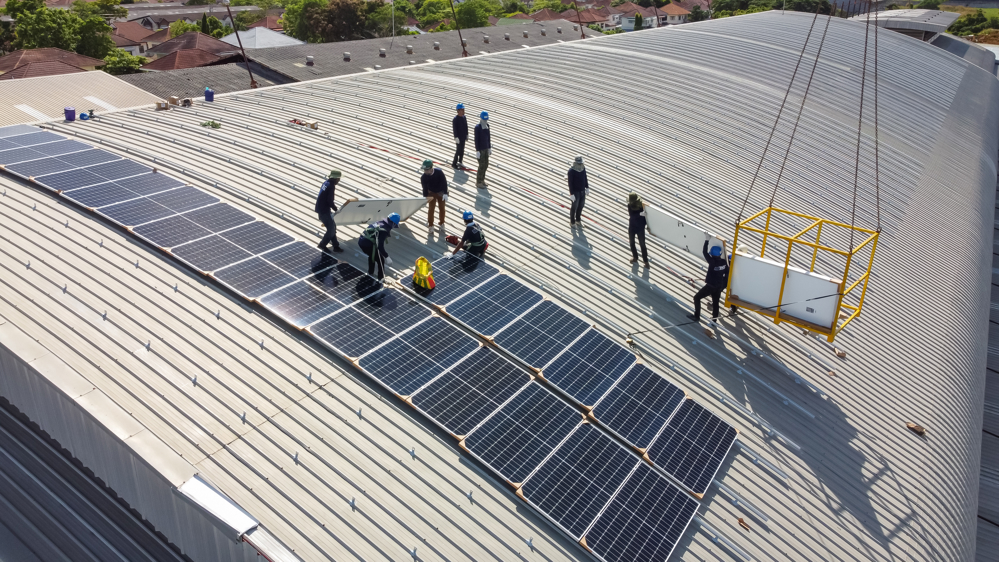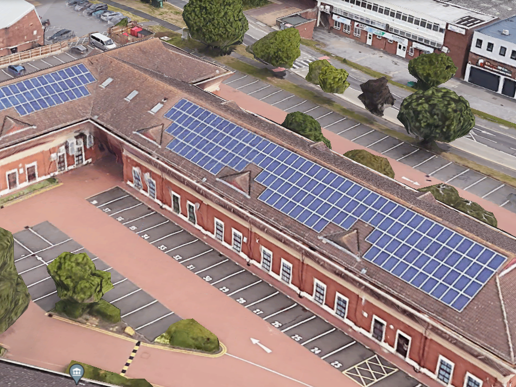Why decarbonise?

In a world of changing environmental and legislative expectations, it’s easy for terms and phrases like ‘decarbonisation journey’ and ‘energy management’ to become lost. But they are important phrases for the future of buildings and energy. Read on as we explore ‘what decarbonisation means’ and the key reasons for your business to begin this process with your fleet and building.
Decarbonisation is a term used for removing or reducing the carbon dioxide (CO2) you or a company produces.
At Ground Control we are focusing on our clients' built environment and reducing their carbon footprint through the installation of green and smart technology. We can do this through several avenues, be it adding solar PV, swapping fossil fuel heat sources for energy-efficient green technologies such as air source heat pumps, or replacing outdated luminaries or motors.
We can also monitor and track areas of heavy energy usage with building energy management systems (BEMS) which gives us the ability to process, monitor, control, and conserve your building's energy. We can use existing data to drive habitual change or as an indicator to install new technology. A new or adapted energy management system is a key component in your step to the whole building's energy efficiency. BEMS will help you maximise energy efficiency and reduce your carbon footprint. Easy to integrate and install it’s a fundamental part of your energy-saving journey.
With this in mind, here are 5 key reasons to begin your journey.
1. ‘Free-up’ energy for other uses
Several factors determine how much energy your buildings and sites can draw from the grid. At its simplest, this means a building has an ‘energy capacity’ to power systems such as air conditioning and lighting. To make positive changes to your building, you may need to ‘free up’ capacity.
A great starting point is by decarbonising your building to redirect wasted energy into usable energy. You can increase the efficiency and use less energy with upgrades to various systems including; HVAC, LED lighting, and installing a building energy management system.
The result of these changes can free up enough energy for additional low-carbon technologies, such as electric vehicle chargers, without the need for expensive and disruptive energy supply upgrades from your Distribution Network Operator (DNO).
2. Reduce the running costs of your building
There are many ways to reduce your building's running costs. This can be achieved by upgrading current systems, installing new green technologies, or a combination of both.
Dated energy systems use and waste more energy which adds to your bills. But by upgrading in areas such as HVAC and for example installing highly efficient smart electric motors, that same system can use less energy while operating at the same level and in some cases a higher level. The result is quite literally using and paying for less energy for the same output.
You can also move away from the grid and fossil fuels and create your own source of renewable energy with solutions such as photovoltaics panels. In most cases, land or appropriate space for panels is already available on-site. The result is your own renewable energy source. With developing technologies, creative solutions are now available for buildings and sites with roofs unsuitable for traditional panels, or with little available space.
As an added benefit, your excess energy can be banked for future use with the introduction of battery storage.

3. Hit your sustainability and environmental goals
When looking to achieve a reduction in greenhouse gas (GHG) emissions, Scope 1 is usually the first starting point as these are direct emissions from your facilities and fleet, and under your control.
Our services can support you regardless of where you are on your journey, and focuses on achieving the greatest decarbonisation impact on your business.
The added benefit is that by working with GCES, you are also working with a carbon-neutral business whose route to Net Zero has been accepted by the Science Based Targets initiative.

4. Stay ahead of building regulations
Significant changes have been implemented to the building regulations; the changes have been put in place to force a move towards the government's net zero 2050 objectives. Improving your building's energy performance will keep you ahead of the changing Government targets as well as reduce your energy bills and carbon footprint.
5. Protect the value of your building
The governemnt has brought in legislation stating that from 1st April 2027, all non-domestic properties are to have an EPC C or above and from 2030 all non-domestic properties are to be EPC B or above. Earlier deadlines of 2025 and 2028 respectively are in place for domestic properties.
This was shelved in the latest updates from Rishi Sunak however, the targets for 2050 for UK net zero targets are still in place, which brings uncertainty to the rental market. What is clear is that properties with EPCs of B and higher can command a higher rate, longer-term contracts, and increased market interest. Talk to Ground Control about getting a plan in place to raise your EPCs today.
How GC Energy Solutions can help
As a proud member of the Ground Control family, we have been helping customers achieve their goals for 50 years and leading the way in adjusting our business to meet the needs of a changing world.
Our energy solutions help you to understand your energy and action on your environmental commitments. Allowing you to:
- Improve your EPC energy rating to reduce your bills, protect the value of your building, and increase its rental value.
- Reduce your reliance on the grid and unlock additional energy to use.

Decarbonising Kingfisher House

Decarbonising a motorway services chain





